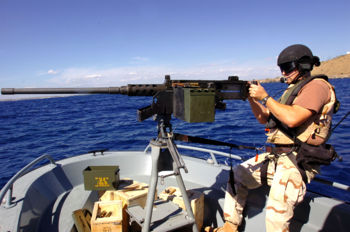M2 machine gun: Difference between revisions
imported>Howard C. Berkowitz No edit summary |
imported>George Swan (add image) |
||
| Line 1: | Line 1: | ||
{{subpages}} | {{subpages}} | ||
{{Image|Coast Guard sailor points 50 caliber MG -- Guantanamo.JPG|right|350px|A USCG sailor aims an M2 machine gun.}} | |||
Arguably the most successful heavy [[machine gun]] in history, the .50 caliber '''M2 machine gun''' was designed by [[John Browning]] near the end of the [[First World War]], and entered U.S. service in the 1920s. It remains in active use today, nicknamed the "Ma Deuce". It is effective against light armor, slow-moving aircraft, vehicles and personnel. | Arguably the most successful heavy [[machine gun]] in history, the .50 caliber '''M2 machine gun''' was designed by [[John Browning]] near the end of the [[First World War]], and entered U.S. service in the 1920s. It remains in active use today, nicknamed the "Ma Deuce". It is effective against light armor, slow-moving aircraft, vehicles and personnel. | ||
Revision as of 12:50, 24 April 2011
Arguably the most successful heavy machine gun in history, the .50 caliber M2 machine gun was designed by John Browning near the end of the First World War, and entered U.S. service in the 1920s. It remains in active use today, nicknamed the "Ma Deuce". It is effective against light armor, slow-moving aircraft, vehicles and personnel.
The weapon is recoil-operated and air cooled. It may be mounted on a tripod for infantry use; the gun (84 lb/34 kg) and ammunition (35lb/15kg per 100 rounds) is heavy but can be carried for short distances. More commonly, it is on some type of vehicle mount, such as a "pintle" pedestal or coaxially with a cannon. Coaxial mounts are used both for lethal fire, and also to verify the aim of the main gun.
In practice, the M2 has an effective direct fire range of about 1 mile/1.6 km, although it occasionally has been used for indirect fire at up to 4.2mi/6.8 km. It can be fired in single shots, and in sniping applications, may have longer range.
Especially in World War II implementations when it might be in a quad mount on a vehicle, or on a B-25 Mitchell bomber with up to 14 forward-facing guns, it can be far more devastating than is usually associated with machine guns. Extended bursts from the attack bombers could cause major damage to Japanese destroyers, much less cargo ships.
